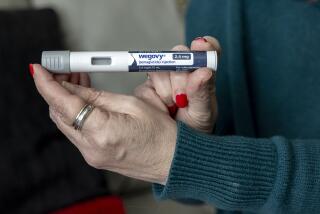Stomach banding is seen as diabetes cure
- Share via
Stomach-banding surgery for weight loss cured nearly three-quarters of obese patients with Type 2 diabetes, five times as many as could be cured by medications, dieting and lifestyle changes, Australian researchers reported today in the Journal of the American Medical Assn.
In the first head-to-head comparison of banding and conventional weight-loss techniques, obesity specialist John B. Dixon of Monash University in Melbourne and his colleagues found that patients receiving the band lost an average of 20.7% of their body weight, while those on a medically supervised diet lost 1.3%.
Among those who lost at least 10% of their body weight -- a number that included only one of those on the medically supervised diet -- 87% were able to stop taking all diabetes medications within a year. Among those on the diet who did not lose that much, only 12% were able to stop taking medications, and all of them had very mild cases of diabetes to begin with.
The results were “clear and striking,” Dr. David E. Cummings and Dr. David R. Flum of the University of Washington wrote in an editorial in the same journal. “It may be time to view bariatric operations . . . as interventions about which all obese patients with diabetes should be informed and given access.”
Other studies have shown that the more invasive form of bariatric surgery, called a gastric bypass, produces an even bigger weight loss and cures Type 2 diabetes in 80% to 85% of patients, often within days of the surgery.
The findings demonstrate that “Type 2 diabetes is a disease that should aggressively be treated with surgery and not merely controlled with medication,” said Dr. Mitchell Roslin of Lenox Hill Hospital in New York, who was not involved in the study.
“The truth is that the treatment of diabetes requires a lifestyle modification, and only surgery makes that practical for the majority of obese diabetics,” he said.
Nearly 20 million Americans have Type 2 diabetes, which is typically associated with obesity. Diabetes is the fifth-leading cause of death in this country; its death toll has grown by 45% since 1987, even while the number of deaths from heart disease, cancer and stroke has been declining.
Bariatric surgery also has been growing, with the number of procedures performed yearly reaching 200,000 in 2006, or 15 times as many as were performed eight years earlier. Still, researchers estimate that only about 1% of those who meet eligibility criteria for the surgery receive it.
The two major forms are banding and gastric bypass. In banding, an inflatable silicon band is placed around the stomach to limit its capacity. In a bypass, the stomach’s size is reduced by creating a small pouch at the top to which the intestines are reattached.
The 20% weight loss with banding in the Australian study is slightly better than many other researchers have reported, perhaps because the Melbourne group has a widely acclaimed protocol for follow-up after the procedure. The bypass produces a loss of as much as a third of body weight, but it has a slightly higher risk of complications.
The big difference between the two procedures is that gastric bypass produces a much more rapid remission in diabetes, often within days. Obesity experts are not sure about the mechanism, but they speculate that manipulating the intestines produces a beneficial change in the levels of leptin and other hormones linked to diabetes.
There have been no head-to-head studies of the two types of surgery, said Dr. Edward H. Phillips, a bariatric surgeon at Cedars-Sinai Medical Center, who was not involved in the new study. But “if you require insulin, you are better off going right to a bypass because the insulin requirement will drop” almost immediately, he said.
The study was limited by its small size -- it involved only 60 patients who were randomly assigned to receive either surgery or medically supervised weight loss.
The patients also had been diagnosed with diabetes within two years before the surgery and did not suffer complications, such as peripheral neuropathy.
But other researchers, including Phillips, have obtained similar rates for the cure of diabetes in nonrandomized studies, and most are convinced that the surgery is the most effective approach for the majority of patients.
The Melbourne study was funded by Monash University. Medical device makers Allergan Medical and Applied Medical Resources Corp. donated the devices that were used. Dixon and other authors reported having received speaker’s fees from Allergan and other companies.
--






